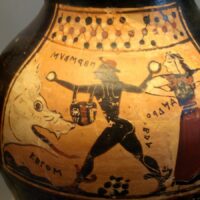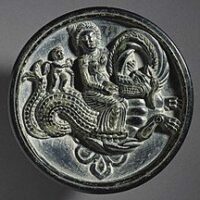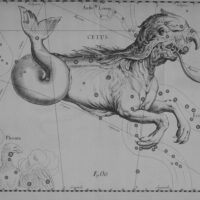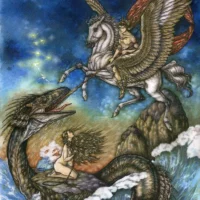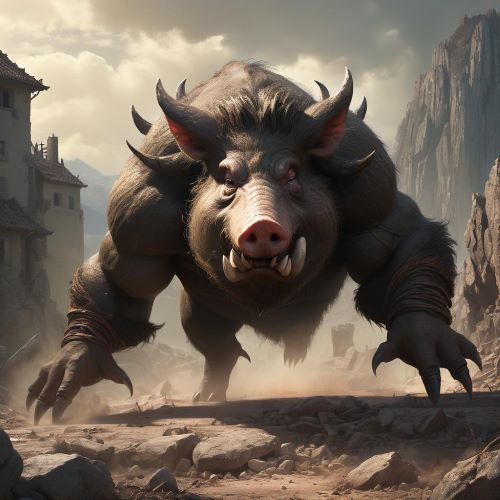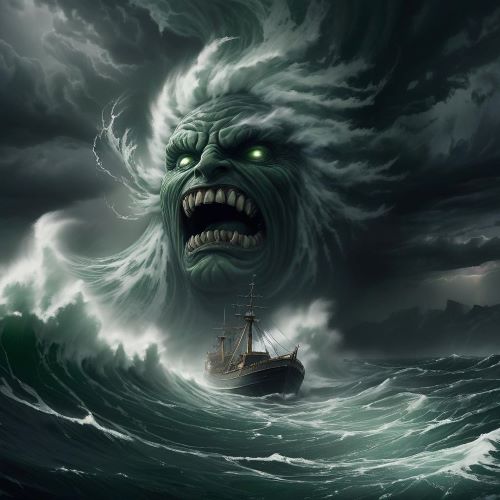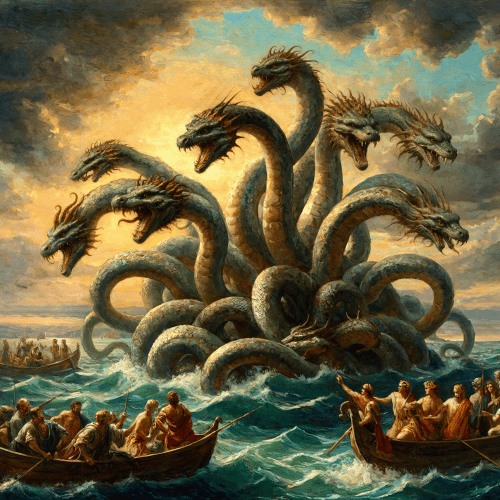Cetus : The Monstrous Serpent
Listen
At a glance
| Description | |
|---|---|
| Origin | Greek Mythology |
| Classification | Animals |
| Family Members | N/A |
| Region | Greece |
| Associated With | Sea, Punishment |
Cetus
Introduction
In Greek mythology, Cetus represents the boundless and terrifying power of the ocean. Known for its monstrous size and fearsome appearance, Cetus has been immortalized in various myths and legends as a symbol of chaos and danger lurking beneath the waves. The term “Cetus” wasn’t used for a specific creature but rather for monstrous sea beings in general. The most famous Cetus appears in the myth of Perseus and Andromeda, a tale of sacrifice, heroism, and divine wrath. Often depicted as a giant sea serpent, Cetus embodies the perils of the sea. The term “cetacean,” used for whales, derives from Cetus.
Physical Traits
Cetus, a gargantuan sea creature in Greek mythology, embodies the untamed might of the ocean. Often depicted with features combining a fish, a whale, and a serpent, Cetus strikes fear into sailors and adventurers. Its body is covered in tough, impenetrable scales, and its large, menacing head has gaping jaws lined with sharp teeth, ready to devour anything. Some myths describe Cetus with multiple terrifying heads. The creature’s size is emphasized, often being large enough to swallow ships whole.
Cetus is depicted variously across Greek myths, sometimes as a colossal serpent-like creature, other times with the head of a wild boar or greyhounds and the body of a whale or dolphin. Its tail is often divided and fan-like, adding to its nightmarish appearance. Ancient texts describe Cetus as rivaling ships in size, with skulls measuring up to 40 feet and spines as thick as a cubit (about 18 inches). Skeletal remains were said to dwarf even the largest elephants at the shoulder. Cetus’s immense size and ferocious nature made it a relentless predator, striking terror into sailors and coastal dwellers.
Family
Cetus, in Greek mythology, isn’t an isolated entity but belongs to a broader category of monstrous sea beings. Its name originates from the ancient Greek word “Ketos,” meaning “sea monster” or “great fish.” Cetus shares close relations with creatures like Ceto, a primordial sea goddess who, along with the Titan Pontus, birthed numerous monstrous offspring, including interpretations of Cetus itself. These offspring include well-known beings like the multi-headed Hydra and the serpentine Scylla, reinforcing Cetus’s place among fearsome denizens of the deep.
While not typically associated with a specific family, Cetus is often linked with the sea god Poseidon, who sent it as a form of punishment. In Greek mythology’s intricate genealogical web, Cetus is frequently associated with other monstrous sea entities. Its most notable connection lies with the sea gods Phorcys and Ceto, often identified as Cetus’s parents. Phorcys and Ceto represent the perils of the sea, making their offspring natural embodiments of maritime terror. This lineage places Cetus among other notable sea monsters like Scylla and Charybdis, cementing its role in Greek mythos as a creature of great peril. Some stories also connect Cetus with the Gorgons, another group of fearsome beings born of Phorcys and Ceto, known for their petrifying gaze.
Other names
In Ancient Greek, the term for Cetus is “kētŏs” (κῆτος), with the plural forms being “kētē” or “kētea” (κήτη, κήτεα), which is Latinized as “cetus” with plural forms as “ceti” or “cetē” = “cetea”. While “Cetus” is widely recognized, the creature appears under various names in different myths. In some versions of the Perseus and Andromeda tale, Cetus is called a “kêtos” or simply a “sea monster.” Hesiod mentions a monstrous sea serpent guarding the Golden Apples of the Hesperides, which could be interpreted as another form of Cetus.
These alternate names underscore the universality of the Cetus myth. It represents the primal fear of the unknown depths of the ocean. The various names associated with Cetus serve as a chilling reminder of the many dangers beneath the waves. Cetus is known by various names and titles across different myths and cultures. In Greek, “Κῆτος” (Kētos) generically describes a large sea monster or whale, adopted by the Romans as “Cetus” or “Cetea.” The myth of Perseus and Andromeda has solidified Cetus’s place in literature. In some versions, Cetus is referred to as the “Kraken,” a term sometimes used interchangeably with Norse mythology’s monstrous sea creatures. These diverse names reflect Cetus’s widespread influence across different traditions and languages.
Powers and Abilities
Cetus, a formidable sea monster in Greek mythology, embodies the dangers and unpredictability of the sea, primarily through its immense size and strength. Poseidon sent Cetus to punish the kingdom of Ethiopia, showcasing its role as a terrifying force under divine command. These creatures were unparalleled predators in their aquatic domain, capable of crushing ships with their colossal bodies and devouring anything in their path. Some interpretations suggest Cetus possessed intelligence, as seen in its role in the myth of Perseus and Andromeda, where it acted under Poseidon’s orders.
While there’s limited evidence of specific magical abilities, Cetus’s association with Poseidon implies a connection to the power of the sea itself, potentially granting control over waves and currents. Endowed with formidable powers, Cetus’s impenetrable scales serve as natural armor, protecting it from attacks. Its jaws inspire fear, capable of destroying ships and consuming humans whole. Additionally, Cetus is often credited with the ability to stir up storms and waves, further enhancing its menace. Some tales even attribute regenerative abilities to Cetus, allowing it to heal and continue its reign of terror. These attributes combine to make Cetus an almost invincible adversary, reflecting the ancient Greeks’ fear and reverence for the sea’s unpredictable nature.
Modern Day Influence
The myth of Cetus continues to inspire awe. From paintings and sculptures to movies and video games, this monstrous form serves as a powerful symbol of the ocean’s hidden dangers and vast mysteries. Its influence extends beyond art. The scientific term “cetacean” for whales and dolphins, and the constellation Cetus resembling a whale in the night sky, both stem from the Greek word “Cetus,” solidifying the enduring impact of this myth on our understanding of the ocean and its inhabitants.
Related Images
Frequently Asked Questions
What is lorem Ipsum?
I am text block. Click edit button to change this text. Lorem ipsum dolor sit amet, consectetur adipiscing elit. Ut elit tellus, luctus nec ullamcorper mattis, pulvinar dapibus leo.
What is lorem Ipsum?
I am text block. Click edit button to change this text. Lorem ipsum dolor sit amet, consectetur adipiscing elit. Ut elit tellus, luctus nec ullamcorper mattis, pulvinar dapibus leo.
What is lorem Ipsum?
I am text block. Click edit button to change this text. Lorem ipsum dolor sit amet, consectetur adipiscing elit. Ut elit tellus, luctus nec ullamcorper mattis, pulvinar dapibus leo.
What is lorem Ipsum?
I am text block. Click edit button to change this text. Lorem ipsum dolor sit amet, consectetur adipiscing elit. Ut elit tellus, luctus nec ullamcorper mattis, pulvinar dapibus leo.
What is lorem Ipsum?
I am text block. Click edit button to change this text. Lorem ipsum dolor sit amet, consectetur adipiscing elit. Ut elit tellus, luctus nec ullamcorper mattis, pulvinar dapibus leo.


